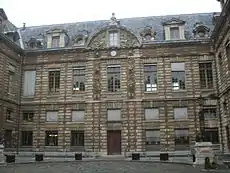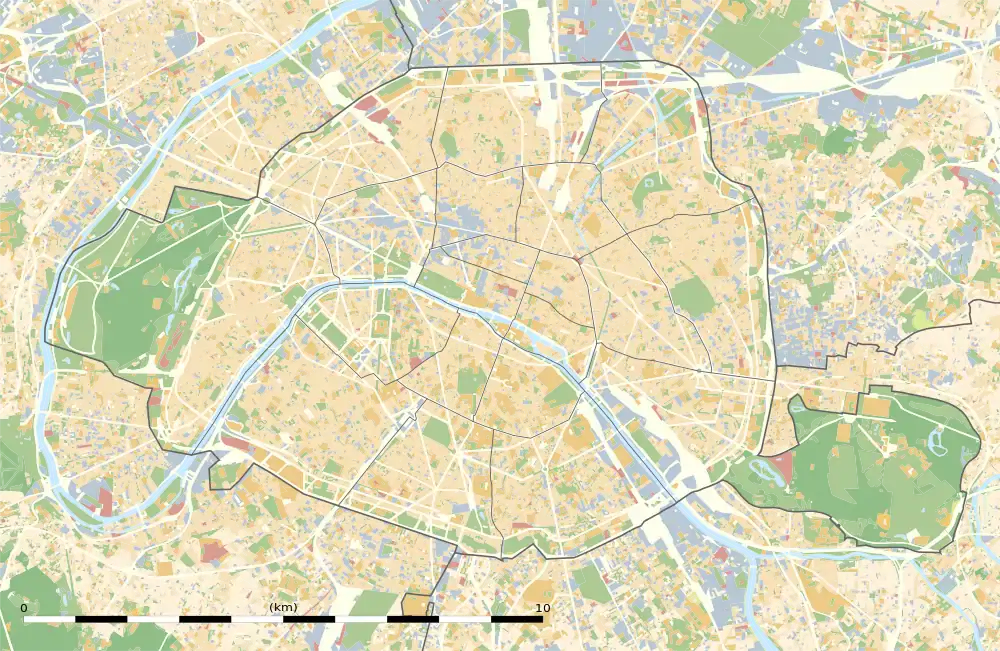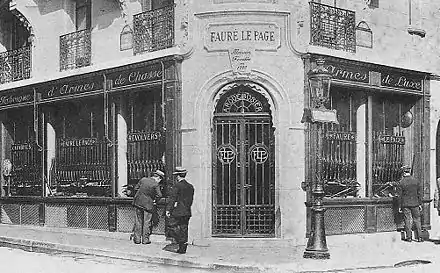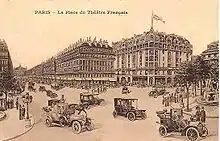Rue de Richelieu
Rue de Richelieu is a long street of Paris, starting in the south of the 1st arrondissement, ending in the 2nd arrondissement. For the first half of the nineteenth century, before Georges-Eugène Haussmann redefined Paris with grand boulevards, it was one of the most fashionable streets of Paris:
 Bibliothèque nationale de France, 58 rue de Richelieu | |
 Shown within Paris | |
| Length | 990 m (3,250 ft) |
|---|---|
| Width | 12 m (39 ft) |
| Arrondissement | 1st, 2nd |
| Quarter | Palais Royal. Vivienne. |
| Coordinates | 48°52′05″N 2°20′18″E |
| From | 2 Place André Malraux |
| To | 1 Boulevard des Italiens |
| Construction | |
| Completion | November 23, 1633 (from place Colette to rue Feydeau), October 18, 1704 beyond |
| Denomination | 1634?, then 1806 |
It is most notable for scattered coin dealers and currency changers, being near the Paris Bourse, the stock market.
Name

The old Fauré Le Page store is located at 8, rue de Richelieu in Paris

The Royal Palace Hôtel -inaugurated in 1909
It is named for the Cardinal de Richelieu, chief minister of Louis XIII from 1624 to 1642.
The street was originally called the rue Royale and then rue de Richelieu soon after. The name was changed to the rue de la Loi during the French Revolution; its name was restored to Richelieu in 1806.
Buildings of note
- Palais Royal, a Richelieu's residence (Monument historique)
- Bibliothèque nationale de France, a historical building (site Richelieu) (Monument historique)
- Comédie-Française, main hall (salle Richelieu)
- The old Fauré Le Page store located 8 rue de Richelieu at the corner of the rue de Richelieu and the rue de Montpensier. The famous firearms played an active role to the French Revolution by distributing arms to the people in 1789 and in 1830.
- The former Royal Palace hôtel which opened in 1909 was located in the same building as the Fauré Le Page store.
- The birth of the croissant itself—that is, its adaptation from the plainer form of kipferl, before the invention of viennoiseries—can be dated to at least 1839 (some say 1838) when an Austrian artillery officer, August Zang, founded a Viennese bakery ("Boulangerie Viennoise") at 92, rue de Richelieu in Paris.[1]This bakery, which served Viennese specialties including the kipferl and the Vienna loaf, quickly became popular and inspired French imitators (and the concept, if not the term, of viennoiserie, a 20th-century term for supposedly Vienna-style pastries). The French version of the kipferl was named for its crescent (croissant) shape and has become an identifiable shape across the world.[citation needed]
Access
| Located near the Métro stations: Richelieu - Drouot and Palais Royal - Musée du Louvre. |

Rue de Richelieu, looking towards the Louvre
References
- The 1839 date, and most of what follows, is documented in Jim Chevallier, August Zang and the French Croissant: How Viennoiserie Came to France, p. 3–30; for the 1838 date, see Giles MacDonogh "Reflections on the Third Meditation of La Physiologie du goût and Slow Food" Archived 3 March 2016 at the Wayback Machine (p. 8); an Austrian PowerPoint – Ess-Stile Archived 29 May 2012 at the Wayback Machine – gives the date of 1840 (slide 46). A 1909 image of the bakery shows the same date for its founding, but the bakery was already documented in the press before that.
This article is issued from Wikipedia. The text is licensed under Creative Commons - Attribution - Sharealike. Additional terms may apply for the media files.